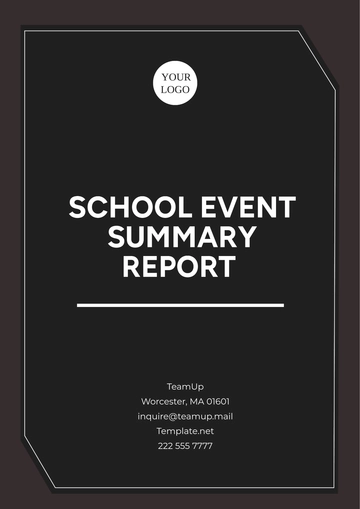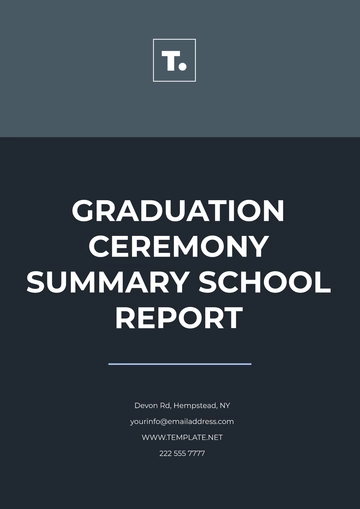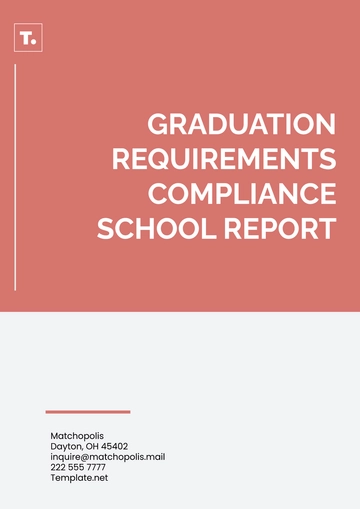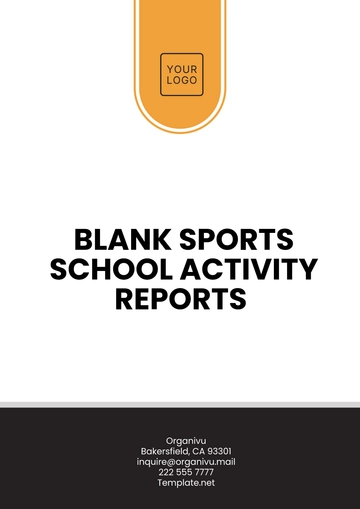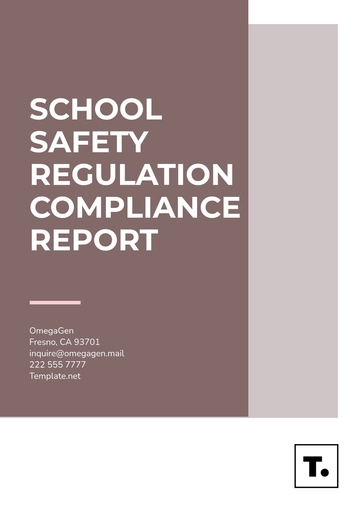Free School Inspection Visit Report

I. Introduction
This report documents the observations, assessments, and evaluations made during the inspection visit to [Your Company Name] on 25th January 2050. The primary objective of the inspection was to assess key aspects of the school's operations, including the quality of teaching, the learning environment, student academic performance, school management, and overall infrastructure. The visit was part of a routine evaluation by the Education Standards Authority (ESA) to ensure that the school adheres to the highest standards of education. The report summarizes the key findings from the visit and provides actionable recommendations to support continuous improvement in the school's performance.
II. Summary of Findings
The inspection of [Your Company Name] revealed several strengths, alongside areas that require attention. The quality of teaching was found to be generally strong, although there were noted inconsistencies in how teachers implemented differentiated instruction. The learning environment was supportive of student growth, but overcrowded classrooms were observed, particularly in the lower grades. Student performance was mixed, with some subjects showing excellent progress, while others demonstrated the need for targeted interventions. The school’s management exhibited a clear commitment to improvement but will need to address certain outdated policies. The infrastructure, while functional, revealed a need for modernization and better maintenance to align with the school's growing demands.
III. Performance in Key Areas
A. Teaching Quality
The overall teaching quality at [Your Company Name] was good, with many teachers demonstrating a solid understanding of their subjects. However, some inconsistencies in the use of pedagogical techniques were noted, particularly in the areas of student engagement and assessment methods. Below is a detailed evaluation of key teaching criteria:
Criteria | Rating (1-5) |
|---|---|
Lesson Planning | 4 |
Subject Knowledge | 5 |
Engagement with Students | 3 |
Assessment Techniques | 3 |
Inclusivity | 4 |
Lesson Planning: Teachers generally provided well-structured lesson plans, but some variability was noted in integrating digital tools and interactive content.
Student Engagement: Classroom observations indicated that while many students were actively engaged, a significant number struggled to participate, particularly in larger, overcrowded classes.
Inclusivity: The school made an effort to incorporate inclusive teaching practices, but more attention is needed to support students with diverse learning needs.
B. Learning Environment
The school has cultivated a positive learning atmosphere, supported by well-maintained facilities, but the inspection team noted a few key challenges that could hinder student development:
Overcrowded Classrooms: Several classrooms, especially in the elementary grades, exceeded the ideal student-to-teacher ratio, which negatively impacted teacher-student interaction and the overall quality of learning.
Library Resources: The school library requires an update in its digital and physical collections to provide students with access to the latest materials in both STEM and humanities subjects.
Sports and Play Areas: Outdoor facilities were in use, but showed clear signs of wear and tear. Regular maintenance of playgrounds and sports equipment is recommended.
C. Student Performance
The inspection team reviewed academic data from [Your Company Name], which showed variability across different subjects. Noteworthy trends were identified, as shown below:
Subject | Average Score | Remarks |
|---|---|---|
Mathematics | 72% | Good performance, but intervention programs are needed for weaker students. |
Science | 85% | Consistently high performance, especially in STEM-based projects. |
English | 68% | Student performance was satisfactory, though gaps were evident in writing skills. |
Social Studies | 88% | Excellent performance, with students showing a deep understanding of global issues. |
English: While reading comprehension skills were strong, many students demonstrated difficulty in constructing well-written essays and arguments. It is recommended that additional writing workshops be introduced.
Mathematics: Though the majority of students performed well, a significant minority struggled with more advanced concepts, particularly in algebra and geometry. Targeted remedial classes may help bridge the gap.
D. Management
The school’s leadership has demonstrated a commitment to ongoing improvement, with various initiatives designed to enhance both academic performance and the welfare of students. However, some areas require attention:
Staff Development: The administration provides regular opportunities for teacher professional development, but there is room to expand training in areas such as digital pedagogy and student well-being.
Health and Safety: Policies related to health and safety need to be updated to reflect modern standards, particularly concerning emergency preparedness and student mental health services.
Student Welfare Programs: There is an evident need to strengthen student counseling services, especially to address mental health concerns arising from the increasing academic pressures.
E. Infrastructure
The infrastructure of [Your Company Name] is overall adequate, though improvements are needed to meet the evolving demands of a 21st-century learning environment:
Aging Buildings: While the main buildings are structurally sound, several areas require renovation, particularly the roofing and classroom ventilation systems.
ICT Facilities: The school has integrated basic ICT into its curriculum, but upgrading the school's internet bandwidth and providing more digital devices will be crucial to support modern teaching methods.
Sanitation: The restrooms were clean but needed modernization, especially in terms of waste management and water-saving technologies.
IV. Recommendations
Based on the observations and evaluations, the following recommendations are made:
Standardize Teaching Methods: Introduce training programs aimed at reducing variability in teaching practices, with a focus on student engagement and differentiated instruction.
Expand Classroom Capacity: To address overcrowding, explore expanding classroom spaces or introducing staggered shifts to better manage student numbers.
Remedial Support: Establish after-school remedial classes for students struggling in mathematics and English, ensuring that no student is left behind.
Policy Updates: Review and update all health and safety policies to align with the latest standards in emergency procedures, mental health care, and student well-being.
Upgrade Infrastructure: Allocate funds for the maintenance and modernization of key infrastructure, including classrooms, ICT facilities, and sanitation areas.
V. Conclusion
The inspection visit to [Your Company Name] on 25th January 2050 identified many strengths in the areas of teaching quality and student performance in science and social studies. However, significant challenges remain, particularly in addressing overcrowded classrooms, ensuring uniform teaching quality, and modernizing infrastructure. The school management's dedication to improvement is commendable, but implementing the outlined recommendations will be critical to achieving long-term success. Regular follow-up inspections and continuous professional development for staff are advised to ensure sustainable growth and improvement in the school’s overall performance.
- 100% Customizable, free editor
- Access 1 Million+ Templates, photo’s & graphics
- Download or share as a template
- Click and replace photos, graphics, text, backgrounds
- Resize, crop, AI write & more
- Access advanced editor
Streamline your school evaluations with Template.net’s School Inspection Visit Report Template. This editable and customizable template allows you to document vital information during school inspections. Tailor the report to meet your specific needs using our Editable in our Ai Editor Tool, ensuring thorough assessments of school facilities, policies, and educational practices.
You may also like
- Sales Report
- Daily Report
- Project Report
- Business Report
- Weekly Report
- Incident Report
- Annual Report
- Report Layout
- Report Design
- Progress Report
- Marketing Report
- Company Report
- Monthly Report
- Audit Report
- Status Report
- School Report
- Reports Hr
- Management Report
- Project Status Report
- Handover Report
- Health And Safety Report
- Restaurant Report
- Construction Report
- Research Report
- Evaluation Report
- Investigation Report
- Employee Report
- Advertising Report
- Weekly Status Report
- Project Management Report
- Finance Report
- Service Report
- Technical Report
- Meeting Report
- Quarterly Report
- Inspection Report
- Medical Report
- Test Report
- Summary Report
- Inventory Report
- Valuation Report
- Operations Report
- Payroll Report
- Training Report
- Job Report
- Case Report
- Performance Report
- Board Report
- Internal Audit Report
- Student Report
- Monthly Management Report
- Small Business Report
- Accident Report
- Call Center Report
- Activity Report
- IT and Software Report
- Internship Report
- Visit Report
- Product Report
- Book Report
- Property Report
- Recruitment Report
- University Report
- Event Report
- SEO Report
- Conference Report
- Narrative Report
- Nursing Home Report
- Preschool Report
- Call Report
- Customer Report
- Employee Incident Report
- Accomplishment Report
- Social Media Report
- Work From Home Report
- Security Report
- Damage Report
- Quality Report
- Internal Report
- Nurse Report
- Real Estate Report
- Hotel Report
- Equipment Report
- Credit Report
- Field Report
- Non Profit Report
- Maintenance Report
- News Report
- Survey Report
- Executive Report
- Law Firm Report
- Advertising Agency Report
- Interior Design Report
- Travel Agency Report
- Stock Report
- Salon Report
- Bug Report
- Workplace Report
- Action Report
- Investor Report
- Cleaning Services Report
- Consulting Report
- Freelancer Report
- Site Visit Report
- Trip Report
- Classroom Observation Report
- Vehicle Report
- Final Report
- Software Report





